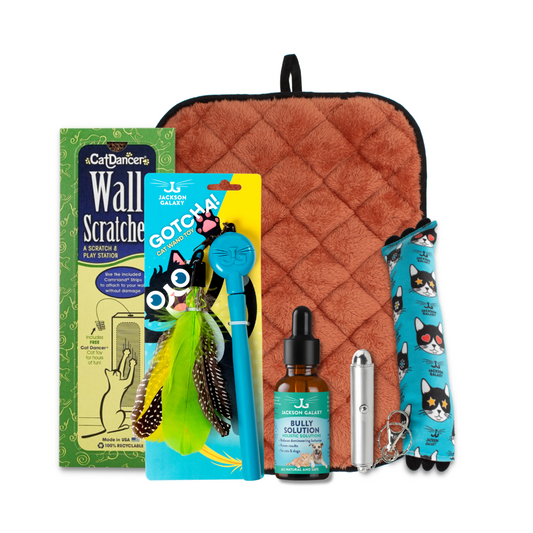A note about this series: Introducing cats to other animals can be a tricky affair. That said, it can also be smooth sailing, with very little potential conflict. And, it could fall somewhere between the two. Every animal is an individual, as is every human and every household. That’s exactly why I’ve made this series exhaustive in detail; I want to serve as many of those individuals as possible, and set everyone up for the best life possible.
Please don’t think that just because I’ve covered every angle, that means that cats are better left living on their own. I believe strongly that, by and large, cats should be with other cats. You may find that to serve the needs of both humans and non-humans in your home, you can move through some of these steps with ease. Great! And it’s equally fine if it takes awhile to get from beginning to end. Just remember: in the world of relationships, nothing is ever one-size-fits-all. It’s a process best served by being patient, empathetic and mindful.
Now, let’s do this…with light, love and Mojo!
Episode Two: Welcome Home!
In Episode One, we talked about Proactive Preparation and covered the three fundamental steps to take before you bring your new cat home:
A. Establish a consistent routine of mealtime (as opposed to free feeding);
B. Integrate a few Catification ideas around your home as a way of optimizing and maximizing your cat’s living space;
C. Set up a separate “base camp” for the newcomer to ensure a sense of the all-important territorial security.
Now, it’s time to bring your new cat into the family fold. Let’s continue with the recipe I’ve used for years to ensure the smoothest transition.

Step Two: Coming Home, and the Mandatory Isolation Phase
1. The “Coming Home” Moment
Now comes that wonderful, exciting moment: It’s time to bring your new cat home! Make sure your resident cat is temporarily tucked away in a back bedroom or someplace where he will not see you bringing your new cat into the house, then proceed directly to the new base camp. Get your new cat settled in as best as you can, keeping in mind that anything you can bring along from the shelter or her foster home that has her scent on it—bedding, blanket, toys, etc.—is a high-value bonus for her comfort and acclimation process.
2. The Mandatory Isolation Phase – No Peeking!
One of the hallmarks of this integration method is that the new cat and the resident will not initially lay eyes on each other. Therefore, the main purpose of this isolation phase is to gradually introduce the cats through scent before they actually see each other. This might seem odd, but let me assure you: this is a nonnegotiable. I’ve noticed that some folks find this to be counterintuitive, since they presume the “mystery” of what the other cat looks like might create even more angst. But actually, this scent-before-sight protocol makes for a much more predictable and harmonious introduction, because they can become familiar with each other prior to any visual assessment.
You might think you can ignore this aspect of the process because of the personality of one or both cats, and how well you feel you matched them. However, introducing through scent first and then visual access is important because it plays into the inherent makeup of cats when it comes to an incursion into their sacred territory. Survival in the wild means assuming the worst but being malleable enough to accept newcomers. Trust me, this one is important—not just to prevent worst-case-scenario conflict, but, as is the fact with many of these points, to build and maintain both cats’ MOJO!
To this end, there are a few things we can do to help this “getting to know you” process along:
A. Scent Swapping
This is one of the most nonthreatening ways to get one cat’s scent in front of the other, and it’s as simple as it sounds.
1. “Gift” for the Resident: You will take a “scent soaker” from the newcomer’s base camp—a blanket, soft fabric toy (that most easily retains her scent), or even something like a doughnut bed—and temporarily place it near the resident cat for his inspection. (You can also gently rub a clean sock or washcloth around the face of the cat to pick up scent that way, then use it as a “scent soaker,” provided that she doesn’t mind you doing that.)
2. “Gift” for the Newcomer: You will take a scent soaker from the resident cat and place it near the newcomer. In both cases, the key is not to force her to smell the item, but to let her explore it at her own pace. And don’t worry, she will get to it, and it will accelerate the initiation process. Think of scent swapping as another type of “remote handshake.”
3. Signposts: Here is yet another Catification concept that can be utilized to help with the introduction process. In this case, you would take a more significant item from the new cat’s base camp (like a cat tree) and place it out in the living room, in a major window. This allows your resident to mark the base camp piece with his own scent, establishing a peaceful co-signpost in the home.
Note: You can up the ante by providing a scent-soaking double whammy—place one of your “gifts” on one of the signposts!
B. Site Swapping
Once your new cat demonstrates mastery of (and Mojo in) base camp, it’s time for the next step: Site Swapping. How will you know she’s mastered base camp? She will appear to be 100 percent comfortable, sitting at the window watching birds and not army crawling, hiding under things, or jumping every time the door’s opened. And then there are the most obvious signs: when she’s sitting right by the door, trying to dash past you every time you open it, or when you hear her scratching/vocalizing on the other side of the door.
Site swapping allows each cat to explore the other’s territory without ever laying eyes on each other. This is also an opportunity for key signposts—like cat trees, litter boxes, etc.—to take on a shared scent.
You site swap on alternating days so no one owns too much land. But you also site swap because if a cat is locked up all day, his energy can build up into a potential “cat bomb.” Here’s how it would unfold:
- Carry the newcomer out of their base camp, put her in the bathroom, and shut the door.
- Allow the resident cat to walk into the newcomer’s base camp, then shut that door.
- Allow the newcomer to explore the rest of the home.
- Rinse and repeat.
From there, it’s just a matter of them having quality time in each other’s environments. I wouldn’t put a timer on it.
Make sure that you’re swapping back at predictable times during the day, so you’re not asking your existing cat to be in a closed space for extended periods or asking the newcomer to sleep around the rest of the house all night long, right off the bat.
Note: When it comes to site swapping, there are no hard and fast rules about when and how often, as long as you are consistent. You don’t want to swap randomly, and you don’t want to allow anyone to get too comfortable in one space. You can swap once a day, every other day, or even two or three times a day if the cats are happy. Just don’t let yourself fall into a rut.
In Episode Three, we’ll get down to the nitty gritty with “The other side of the door” feeding ritual.
Even though this series might seem in depth, you ain’t seen nothing yet! There is actually much more to be found in the chapter that this has been excerpted from in my new book, Total Cat Mojo.














